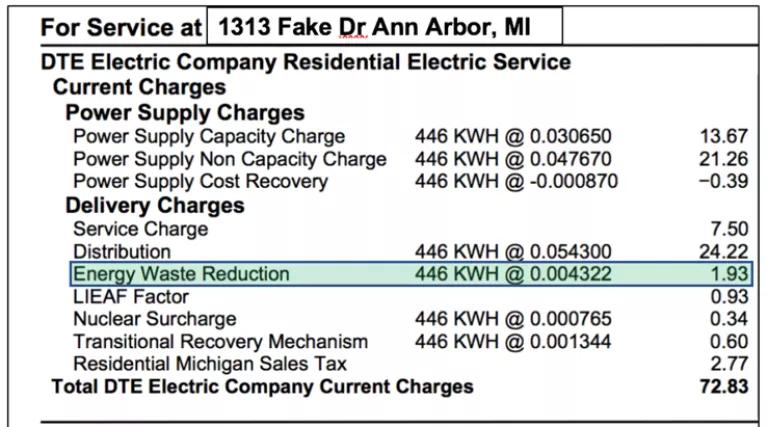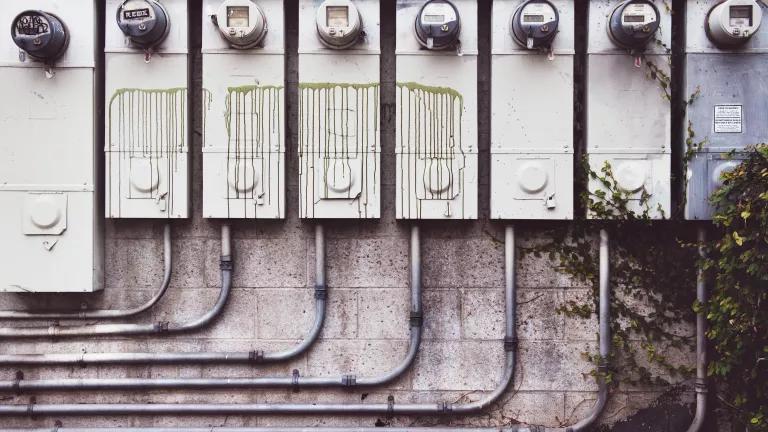Michigan Energy Efficiency Plan Primer

Michigan has massively benefitted from energy efficiency. It has minimized energy consumption, lowered energy bills, and reduced air pollution for families across the state for years.
In the last decade, Michigan’s utilities have helped customers save almost six billion dollars in electric costs and close to 2 billion dollars in natural gas costs. And yet, many know very little about this important resource and the process for capturing all of its benefits.
What Is Energy Efficiency?
Energy efficiency is all about getting the same or better performance from things around our home using less energy. Energy Star labeled lightbulbs and appliances are examples of energy efficiency because they perform your everyday tasks using less energy than other models. Insulation and the sealing of cracks and openings in your home are also examples of energy efficiency because they reduce the amount of energy needed to heat and cool your home.
It's important to draw a distinction between energy efficiency and energy conservation. While both aim to reduce energy use, how they achieve the reduction is different. Energy conservation relies on people cutting back on activities that consume energy such as turning off lights or using appliances less often. Energy efficiency lets the technology or materials do the work.
Finally, the underlying concept for energy efficiency is that customers invest up front in energy efficiency technology that will save them money over time and more than make up for the investment.
What Are the Benefits of Energy Efficiency?
Energy efficiency produces a variety of benefits for families, the utility, and the state as a whole. The benefits of energy efficiency include:
- Reducing the burden of energy bills, particularly for low-income families
- Lower energy use means lower energy bills.
- Creating healthier and more comfortable homes
- Measures such as insulation, air sealing, and upgrades to heating and cooling help to improve the indoor air quality and health conditions inside a home by making homes warmer in the winter and cooler in the summer and reducing in-home moisture, mold, and allergens.
- Preserving affordable housing
- Owners and renters can both benefit when efficiency upgrades lower operating and maintenance expenses and reduce the burden of energy bills.
- Avoiding the need for new energy generation
- Reducing energy use means that there is less need to build more polluting and expensive power plants.
- Reducing air pollution and improving health
- Less need for burning fossil fuel to generate electricity means less pollutants in the air that can damage our health. Pollutants from burning fossil fuels contribute to four of the leading causes of death in the United States: cancer, chronic lower respiratory diseases, heart disease, and stroke so cuts in fossil fuel pollutants deliver big gains in health.
- Improving reliability of the electric system and lowering risk of blackouts
- Reduced energy use also puts less strain on the poles, wires, and infrastructure of the electric system that delivers our energy. This is particularly important given the amount of reliability issues in the state.
- Creating jobs
- The dominating clean energy employer in Michigan continues to be energy efficiency with 85,061 jobs, or about two-thirds of the state’s clean energy jobs. These include jobs related to retrofitting ventilation and air conditioning (HVAC) systems in schools, insulating homes, and manufacturing ENERGY STAR-rated appliances.
Michigan’s Energy Efficiency Law
Energy efficiency standards have been a key tool for delivering energy savings in states across the country including Michigan. 27 states have adopted these policies and their savings have delivered approximately 80% of all utility savings reported across the United States in 2016 and 2017.
Michigan’s first energy efficiency standard began in 2008 when Michigan passed Public Act 295. The standard required utilities to save energy at levels equal to or above 0.3 percent of total annual electricity sales. Over time that standard ramped up to a 1 percent minimum for electricity and .75 percent minimum for gas.
In 2016, Public Act 342 reinforced previous standards and set up a financial incentive for utilities going beyond the 1 percent standard and up to 1.5 percent of total annual electricity sales. Though utilities have been exceeding the 1 percent standard for years, the incentive has successfully pushed both utilities to the 1.5 percent mark, their highest ever levels of efficiency.
According to Public Act 342, investor-owned utilities like Consumers Energy and DTE must file energy efficiency plans with the Public Service Commission every two years to show how they plan to comply with the efficiency standard. The overall stated goal of the energy efficiency plan is to help customers reduce energy waste, minimize the future costs of service, and delay the need for constructing new power generating plants.
Michigan Energy Efficiency Planning Requirements
(With a focus on electric energy efficiency)
Michigan’s Public Act 342 outlines each component that must be included in an energy efficiency plan when it’s filed at the Commission:
- An overview of the programs and individual measures the utility plans to offer for each customer class
- Products and services that reduce energy consumption are often referred to as “measures.” Programs then typically promote many different kinds of measures. Examples of measures include like energy efficient lighting, efficient motors, and insulation.
- Classes are broken up into residential, commercial, and industrial and can have sub-categorization such as income-qualified (low-income) within the residential class.
- An indication of how much money is needed to provide the programs outlined
- A description of how the costs will be recovered
- Legally, utilities are reimbursed the amount of money it cost to provide service to their customers plus a certain amount of profit. Your monthly utility bill is how they “recover” that reimbursement. Your bill multiples your usage by different rates for different items and for utilities like Consumers and DTE that includes a rate or “surcharge” for energy efficiency (see below). Remember though that the investment is made up for over time. In Michigan, for every dollar spent on energy efficiency programs, studies have shown that customers will save around four dollars in avoided energy costs.

- A showing that charges collected from a particular rate class are spent on programs that benefit that class
- This is a simple, but critical concept that is also found in rate cases that is meant to align who pays the costs with who reaps the benefits. This has come into question before and can be a symptom of lack of representation in cases. A separate, but important note is that all customers, even customers who do not participate in energy efficiency programs, benefit from these programs. Those who do participate can receive even greater benefits, but all customers benefit from avoiding the cost of producing energy and needing to build additional power plants which we would all have to pay for via our health and pocketbooks.
- A showing that they will achieve the standard
- How do all the savings from the programs add up to meet or exceed the energy savings standard?
- Different “cost tests” exist that are designed to weigh specific costs and benefits related to programs and portfolios of programs to determine if the benefits outweigh the costs, “cost-effective.” Michigan law specifies the use of the “utility cost test.” Of note, low-income programs are exempt from being cost-effective in recognition that low-income programs can often be more costly, but also can provide more meaningful savings and thus shouldn’t be constrained by traditional cost-effectiveness tests.
- A demonstration that the programs are collectively cost-effective
- Displaying that the utility has the practical and effective administrative capabilities to actually carry out the programs
Approving an Energy Efficiency Plan
The Commission operates in a partially legal proceeding meaning there are lawyers, expert witnesses, and (administrative law) judges. The utility files the plan and then other organizations can participate, or “intervene,” in the case to review, evaluate, support, or critique the plan. A judge then reviews the plan and the information from all parties and makes a recommendation of approval or denial to the Commission and the Commission makes the final decision.
Michigan law states that approval must be based on meeting the utility cost test and being “reasonable and prudent.” In determining whether the plan is reasonable and prudent, the commission shall review each element and consider whether it would reduce the future cost of service for customers. In addition, the commission shall consider at least all of the following:
- The specific changes in customers’ consumption patterns that the proposed plan is attempting to influence.
- The cost and benefit analysis and other justification for specific programs and measures included in a proposed plan.
- Whether the proposed plan is consistent with any long-term energy plan filed by the utility.
- Whether the proposed plan will result in any unreasonable prejudice or disadvantage to any class of customers.
- The extent to which the plan provides programs that are available, affordable, and useful to all customers.
The first three bullets are easy to quantify and establish, but the final two are more difficult and subjective. This doesn’t make them less important—for many customers prejudice, availability, and affordability are more important. What it does mean is that because they can have less documentation and discussion, there is more room for improvement to ensure these areas are being met.
Having a Voice in Efficiency Cases
Energy efficiency is an important resource that can address so much more than just the burden of high utility bills. It can provide a more comfortable, affordable living space, reduce pollution, and create healthier homes. These can only be fully achieved with thorough, diverse input. Here are some ways to be involved:
- Engage with Commission staff (one-on-one meetings/calls, there is also a low-income energy efficiency workgroup open to the public)
- Engagement with your utility directly (public hearings, meetings, calls, etc.)
- Attend trainings about the Michigan Public Service Commission and Michigan energy cases
- Help build public awareness via media (letters to editors, opinion pieces, press conferences), social media, blogs, etc.
- Submit public comments supporting or opposing certain topics
- Mail (be sure to include case number): Executive Secretary Michigan Public Service Commission P.O. Box 30221 Lansing, Michigan 48909
- E-mail: mpscefilecases@michigan.gov
- Share ideas and perspectives with groups that typically intervene
- Direct legal intervention or co-intervention
This is the fourth in a series of blogs aimed making the Michigan Public Service Commission and the decisions that take place there more accessible. In the Michigan Public Service Commission Primer blog, we learned about who the Michigan Public Service Commission is and what they do. In the Michigan Rate Case Primer, we learned the process behind rate cases and its equity implications. In the Michigan Integrated Resource Primer, we learned about the long list of requirements and how to get involved.



